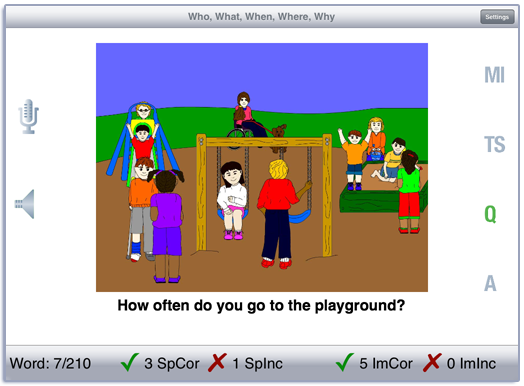
To correctly answer a question a child must first determine what kind of question was asked. For some questions, they must also understand the underlying inference that the question is making. Many children can identify and answer the direct “Wh” questions such as "Who teaches a class?" but cannot answer, "How will he know what kind of robot to build?" To assist the child in developing the inference skills necessary to answer the question, we provide a picture, Main Idea (MI button), and Topic Sentence (TS button).
Listen to the Main Idea (usually just a word) and the Topic Sentence. Discuss how they relate to the picture. This gets the child focused on the details of the picture so that they can more accurately answer the question. Then listen to the Question (Q button). We provide an answer to the question, but our answer is just one of many possible answers. Other answers that the child gives can still be scored as correct. Disagreeing with the answer is also encouraged to demonstrate that different people see the same question and may answer it differently.
The purpose of the exercise is to pay attention to what kind of question is being asked, think about the situation, then answer the question.
The record and playback feature allows the child to record their answer and see if it makes sense to them when they hear it played back. Can they determine if they answered the right kind of question? Was their answer correct?
Target Audience This game is recommended for children with language ages from 6-12. Individuals with language disorders, central auditory processing dysfunction, short term auditory memory dysfunction and those with autism may benefit from learning multiple ways to ask and answer questions.
Just $4.99 on the App Store.
See More Images
View the Wordlist
Information for Professionals
This Intermediate Level app explores traditional “Wh” questions along with 17 additional question categories. The twenty-three categories of questions are: Who, Whose, What, When, Where, Why, How, How Many, Which, Do/Does, Did, Have/Has/Had, Was/Were, Is, Are, May I, Can, Will, Would, Should, Could, If, and Negation. It requires moderate level inference skill.
Clinician guidance is suggested for the first several sessions in order to make the most of the question/answer format. Individuals with language disorders, central auditory processing dysfunction, short term auditory memory dysfunction and those with autism may benefit from learning multiple ways to ask and answer questions.
This game is also appropriate for hearing impaired individuals involved in an auditory habilitation or auditory rehabilitation program. The pictures may also be used to stimulate conversational speech, check auditory comprehension, and for novel sentence generation when presented with a picture.
This app uses the content from the Word Practice game from LocuTour’s Artic Games & More CD and requires moderate level inference skill.
Rationale Responding to a direct question helps the client understand the concept of question/answer and turn taking in conversations. There are multiple opportunities to answer the many different kinds of questions. This helps to reduce perseveration and echolalia if different question types and answers are practiced correctly. Allowing the child to listen to their own answers and score their responses with the adult's feedback, encourages self-monitoring and self-correcting.